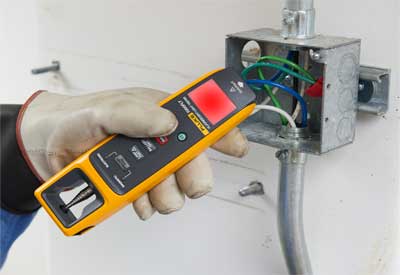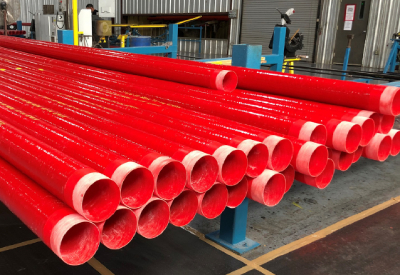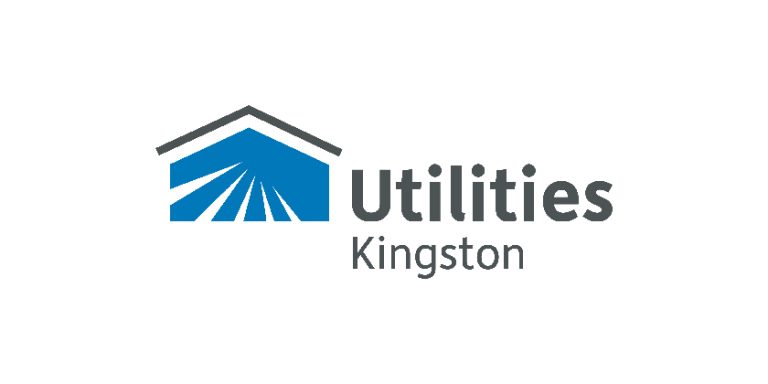Run 5 Essential Lighting Tests in 30 Seconds with Fluorescent Light Tester

If you’re the building maintenance technician for a commercial, retail, or institutional facility with fluorescent lighting, you probably have hundreds or thousands of fluorescent tubes that have to be kept working. And even though those tubes last for tens of thousands of hours, they do fail, some prematurely. And some stop working because of other problems with the ballast they are installed in.
Photo: Red indicates “No Go.”
So if it’s your job to make sure that all those tubes are doing their job, you have quite a bit of ground to cover. In the past, that meant a lot of trial and error. If you found a light that was out, you’d have to climb the ladder, open up the cover, remove the bad tube and replace it. If the new tube didn’t light, you either tried again or had to call an electrician or bring out a voltage tester. That took more time and you hadn’t solved the problem yet.

Photo2: Testing a ceiling light without a ladder
Addressing the needs of users in the field
After hearing this story more than a few times, Fluke decided to develop a tool that takes the trial and error — and a significant amount of time —out of maintaining fluorescent lighting. The result is the Fluke 1000FLT Fluorescent Light Tester, designed to meet the needs of building maintenance professionals. It is a fluorescent lamp tester, ballast tester, non-contact voltage tester, pin continuity tester, and ballast-type discriminator, all in one.
“We listened to customers and looked at what was out there and were able to incorporate all the functionality needed into a single tester that allows building maintenance technicians to troubleshoot all aspects of a fluorescent light system,” says Luis Silva, Product Marketing Manager at Fluke.
Five tests. No waiting
Some fluorescent lighting testers on the market may have one or two testing features. But Fluke wanted to develop a device that takes care of all the essential lighting tests, thus saving workers time, space in their tool bags, and trips up and down ladders. So, rather than having to carry two or three testing tools or call an electrician, they can just carry the 1000FLT to perform:
• Lamp test: Allows testing without removing the tube from the ballast. The tester sends a pulse of energy that lights up the tube if there is gas in it. The 1000FLT is compatible with T5, T8, and T12 fluorescent tubes.
• Ballast test: Easily determines whether the ballast is working.
• Non-contact voltage test: Quickly checks for the presence of voltage without touching the source.
• Pin continuity test: Tests whether filaments in the tube have continuity.
• Ballast-type discriminator: The 1000FLT is the first multi-function tester to include this feature to allow technicians to easily identify whether the ballast is electronic or magnetic without taking the fixture apart and without even climbing a ladder.
Just aim the tester at the ballast from the ground and it will immediately identify which type you have. This helps quickly identify old-style, power hungry magnetic ballasts, for maintenance or replacement.
The 1000FLT user interface was designed to be as simple as possible, and it is. All of these tests deliver instant results. The ballast, voltage, and pin continuity tests indicate results with either a “Go” or “No Go” indicator lights. The ballast-type discriminator lights up either the “magnetic” or “electronic” LED on the face of the tester, while the lamp test result is determined by the user if the tube lights up or not.
Save hours of testing time
You can run all five tests on the 1000FLT in about 30 seconds, so if you have hundreds of fluorescent lights to maintain, that can save hours of testing time every week. “One of our customers, which has one full-time and one half-time building maintenance pros dedicated to fluorescent light maintenance, estimated that together they saved about 40 to 60 minutes testing roughly 50 light fixtures per day with the 1000FLT,” says Silva.
Find out more: http://en-us.fluke.com/products/electrical-testers/Fluke-1000flt-fluorescent-light-tester.html.

Testing a ballast with the Fluke 1000FLT Fluorescent Light Tester.
















